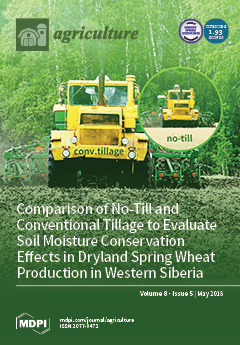Relationships between greenhouse gas emissions, yields, and soil properties are not well known. Utilizing two datasets from long-term cropping systems in Illinois, USA, our we aim to address these knowledge gaps. The objective of this study was to explore the relationships between the
[...] Read more.
Relationships between greenhouse gas emissions, yields, and soil properties are not well known. Utilizing two datasets from long-term cropping systems in Illinois, USA, our we aim to address these knowledge gaps. The objective of this study was to explore the relationships between the physical and chemical properties and greenhouse gas (GHG) emissions of soil, and cash crop yields over a four-year time-period and following 15 years of treatment implementation in Illinois, USA. The experimental layout was a split-plot arrangement involving rotation and tillage treatments in a randomized complete block design with four replications. The studied crop rotations were continuous corn [
Zea mays L.] (CCC), corn-soybean [
Glycine max (L.) Merr.] (CS), continuous soybean (SSS), and corn-soybean-wheat [
Triticum aestivum L.] (CSW), with each phase being present for every year. The tillage options were chisel tillage (T) and no-tillage (NT). We used an array of multivariate approaches to analyze both of our datasets that included 31 soil properties, GHG emissions (N
2O, CO
2, and CH
4) and cash crop yields. The results from our analyses indicate that N
2O emissions are associated with a low soil pH, an increased Al concentration, the presence of soil nitrate throughout the growing season, an increase in plant available water (PAW) and an increased soil C concentration. Likewise, soil CO
2 respiration was correlated with low pH, elevated Al concentrations, low Ca, increased PAW, higher levels of microbial biomass carbon (MBC), and lower water aggregate stability (WAS). Emissions of CH
4 were associated with increased levels of MBC. Lastly, the yield index (YdI) was correlated with lower levels of soil Ca and available P and lower values of WAS. The association between high YdI and lower WAS can be attributed to tillage, as tillage lowers WAS, but increases yields in highly productive cropping systems in the Midwest.
Full article





